MOVIE REVIEW: The Space Between Us
February 2, 2017
Mars. Long a dream of mankind (and especially Buzz Aldrin) is for man to go to Mars. Not just with land rovers and satellites sending images back to Earth, but to walk upon and colonize. NASA and other space agencies have now long been working toward that very goal. Tests done on space shuttle missions, on the International Space Station, and now the "Twins" experiment with astronauts Mark and Scott Kelly, are all yielding results that will further the realization of the Mars dream. Hollywood, always seemingly light years ahead of science, has already gone to Mars and beyond in live action and animation, most recently with "The Martian". But what if a filmmaker pushes the envelope, blending science and accuracy with heart and humanity, and asks a single probative question: What if someone gave birth on a spaceship heading to/or already on Mars? The answer to that question sets the stage for THE SPACE BETWEEN US, a film with a truth and a soul that explores multiple metaphoric concepts about the idea of "space" and how there can be vast space between people and places, but at the same time there is seemingly no space between them. THE SPACE BETWEEN US resonates with a probing beauty on both emotional and physical levels.
Directed by Peter Chelsom and written by Allan Loeb with a story by Richard Barton Lewis (also a producer on the film), Stewart Schill and Loeb, THE SPACE BETWEEN US is the story of Gardner Elliot. Born on Mars as a result of his astronaut mother discovering she was pregnant while in-flight, Gardner has spent the last 16 years of his life knowing a total of 14 people. Sadly, his mother died during childbirth which left the crew, and subsequent others, to raise Gardner. He has never left Mars and longs to experience Earth and become "human." His best friend is a robot named Centaur. But thanks to the internet, Gardner has befriended Tulsa, a teenaged girl in Oklahoma. Damaged, angry and distrustful, as curious as Gardner is and as desirous he is of experiencing a real connection with the "outside world", Tulsa only wants to escape, leave, get out, leave the planet if she could. She has no idea that Gardner is on Mars, believing instead that he lives in New York and can't leave his home because of health issues. (As we see unfold, there ends up being great truth in that small deception.)
Desperate to travel to Earth, Gardner begs and pleads with the space team on Earth for the chance to "be human." One female astronaut, Kendra, was sent to Mars after Gardner's birth to help raise him. She tries to advocate for him, but with trepidation. No one knows how his body will react to different gravitational forces. Going so far as to have implants surgically inserted into his body as a means to reinforce his body for Earth's gravity, it is ultimately decided the trip would be too risky. But Gardner is undeterred.
A computer and electronics whiz, he hacks into his the vault where his mother's possessions have been housed all these years, finding a picture of his mother and a man he believes to be his father. More than ever Gardner wants to travel to Earth and find his father. Plus, he also wants to meet Tulsa with whom he has fallen completely in love with.
Sneaking off and stealing a ship, Gardner heads to Earth. Everything is strange, different and new, but exciting, and Gardner takes in everything with wide-eyed wonderment, eventually making his way to the girl of his dreams, Tulsa. Agreeing to help him find his father, the two take off on a cross-country road trip to Summerland, California, opening up the world for not only Gardner, but the viewing audience. In the meantime, Kendra has followed Gardner back to Earth and Nathaniel Shepherd, the Elon Musk/Richard Branson- esque genius who spearheaded the initial trip to Mars 16 years ago, himself self-exiled after deciding to keep Gardner's birth a secret from the world, now re-emerges, panicked because testing has shown that Earth's gravity will kill Gardner within 72 hours.
But there are secrets that come to light, forever changing the lives of Gardner, Tulsa, Kendra and Nathaniel as each struggles to fill THE SPACE BETWEEN US.
Thanks to Chelsom's storytelling vision and visual detail, compounded by the emotional depth within the story itself, there is an outstanding balance achieved wherein the emotional tonal bandwidth is laced with the truth and authenticity of the science leading to an eye-opening and thoughtful film. Approaching the film as being "connection versus isolation amplified by the vastness of space", there is a flow to the cinematic connective tissue.
Starting with the initial question of "What would happen if an astronaut discovered she was pregnant on a flight to Mars?", the story development is comprehensive and detailed. Relying on scientists at NASA Ames Research Center and expert Professor Scott Hubbard for specifics on space flight to Mars, the human body, gravity, and ethical and logistic considerations - all of which we see play out on screen - THE SPACE BETWEEN US has as a very strong science underpinning on which the story of Gardner Elliot and all the emotional gravitas is built. In speaking with producer Richard Lewis, who spearheaded the entire film and storyline, "We had flight surgeons who were advising us about the birth, what conditions would be like and Scott [Hubbard] referred us to some of the researchers that had taken mice that were pregnant and they put them in orbit as part of the space shuttle program. They gave birth and the mice came back and there were all these anomalies. It would be terrifying actually. The chances of the child going to full gestation would be a challenge. . .So all the things Gary Oldman says in the movie and that they talk about are all based in science."
But going beyond the science, Chelsom focuses on the heart and humanity of THE SPACE BETWEEN US, showcasing each of the four principal characters and their respective human fragility - a boy desperate to be human without really understanding what that means; a girl desperate to avoid humanity because of the hardships and heartache which has consumed her life; a genius visionary who is obsessive compulsive about every detail of his science but can't control his overriding passion for science from obfuscating the humanity of life; and, a female astronaut who put her life as a wife and mother on hold, opting for the excitement of science and exploration only to find her window of time has passed. Each is flawed, broken in some fashion, but each hopeful in their own respect, something which Chelsom brings forth thanks to his casting choices and the performances elicited from each. While moments of the film may feel a bit "saccharine" as if a YA novel, they still work when we remember this is a 16-year old boy experiencing the world, including love, for the first time.
There is no one but for Asa Butterfield who could play Gardner Elliott. Butterfield has that innate sense of wide-eyed innocence that comes through in every performance. Here is no different. He gives Gardner an honesty and openness, and hopeful outlook, that is embraceable and welcoming. A sweet naivete permeates the character and elevates the emotion of the story as a whole as the audience sees the world anew through Gardner's eyes - from his first ride in a biplane (a la "Out of Africa") to encountering dogs for the first time or seeing the ocean and feeling the rush of the surf wash over his body. Thanks to his work in "Ender's Game", Butterfield's return to space is beyond believable, particularly given his expertise working with harnesses in a "zero gravity" environment. However, key to THE SPACE BETWEEN US is that the zero gravity experience is scientifically correct, thus enhancing the medical difficulties encountered by Gardner when on Earth.
As described by director Peter Chelsom, "[W]here other films have not even acknowledged the gravity difference on the Mars surface, I thought we had to because we were a plot point. It's about a boy brought up with that gravity difference and that was very very challenging. It's a lot of harnesses. When you see the spaceship land and you see the character running across the landscape to met them, that wire to that [actor], not only is it slightly slo-motion, but there's a massive crane with a wire coming down lifting him so there's an oddness to his run. Similarly with Carla [Gugino] running on the training track, Asa running on the training track."
Britt Robertson, who has also had her own cinematic experiences with the future and "space travel" in "Tomorrowland", not only gets to play in zero-gravity conditions again, but perfectly fills the bill as wise-cracking, street smart Tulsa. Adding to Robertson's own emotional arc and character shift as Tulsa starts to see the world through Gardner's eyes is the chemistry between Robertson and Butterfield. Magical.
Carla Gugino handily tackles the role of Kendra bringing a confidence to the character but also an emotional confusion over Kendra's maternal instincts towards Gardner.
Scene stealing is Gary Oldman who is simply delicious as Nathaniel Shepherd. Bringing on his best Richard Branson/Elon Musk over-the-top exhilarated enthusiasm, Oldman makes Shepherd's passion for science and discovery and "doing what no one has done" infectious. Sporting a fake tan, bespoke tailored clothing and shoes, and a lush mane of Branson-esque hair, Oldman doesn't hold back for even a moment. You relish watching him as much as you believe he relishes the role.
Dogged in getting the overall visuals and the reality on Mars "right", Chelsom tapped cinematographer Barry Peterson and production designer Kirk Petruccelli to create the worlds in which THE SPACE BETWEEN US lives. Working digitally for the first time, Chelsom and his team capture the magic of Earth and Mars, celebrating not only the visual experience of a fish-out-of-water, but the beauty of wonderment.
Peterson's lighting design both on Earth and Mars is flawless. From an intense sunlit over-naturalized glare and reflection on the Pacific Ocean to the gradient differences of Martian shadows at different times of the day to the parallel horizons of Mars and the Grand Canyon. Differences and similarities of the two worlds are visually celebratory. Hand-in-hand with Peterson's work is that of Petruccelli who pushes the envelope with not only the Martian exteriors, but the interior habitat, countering that with Earth and the touchstones of humanity and life. Thanks to the visual detail, sight gags play out to great effect in both worlds. One of the most powerful scenes in the film, however, is Gardner experiencing rain for the first time as he lifts his arms to the heavens, bathing in the phenomena.
Completing the tapestry is Andrew Lockington's score. At times perhaps a bit over dramatic, the effect is countered with pepperings of pop tunes that embody the teenaged world of Gardner and Tulsa.
Heart, soul and humanity. THE SPACE BETWEEN US fills all the empty spaces within each of our lives. And tissues. Bring lots of tissues.
Directed by Peter Chelsom
Written by Allan Loeb with a story by Richard Barton Lewis, Stewart Schill and Loeb
Cast: Asa Butterfield, Britt Robertson, Gary Oldman and Carla Gugino


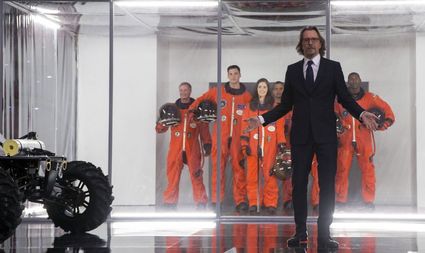

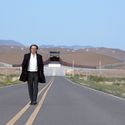
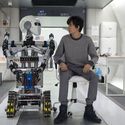
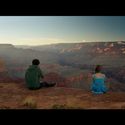


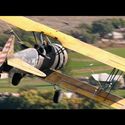
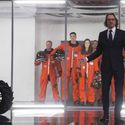


















Reader Comments(0)